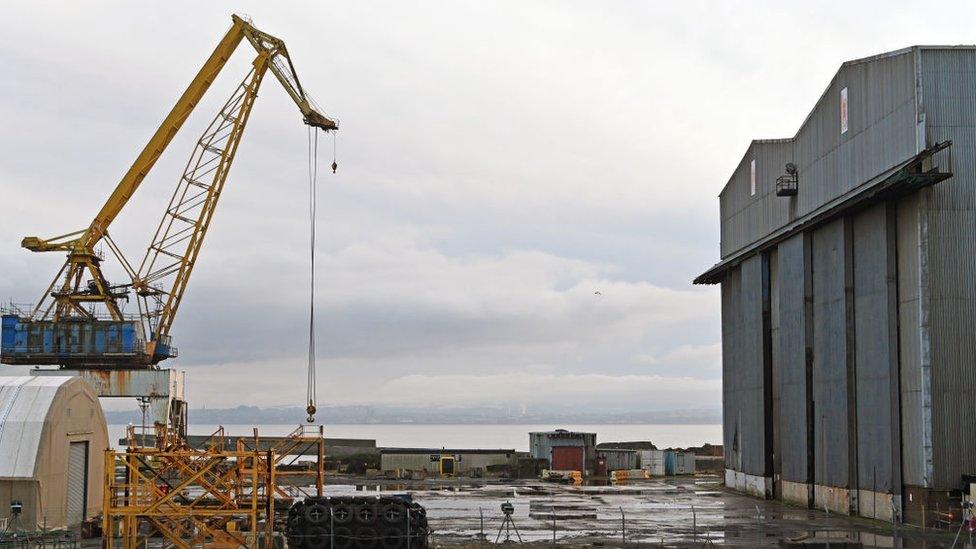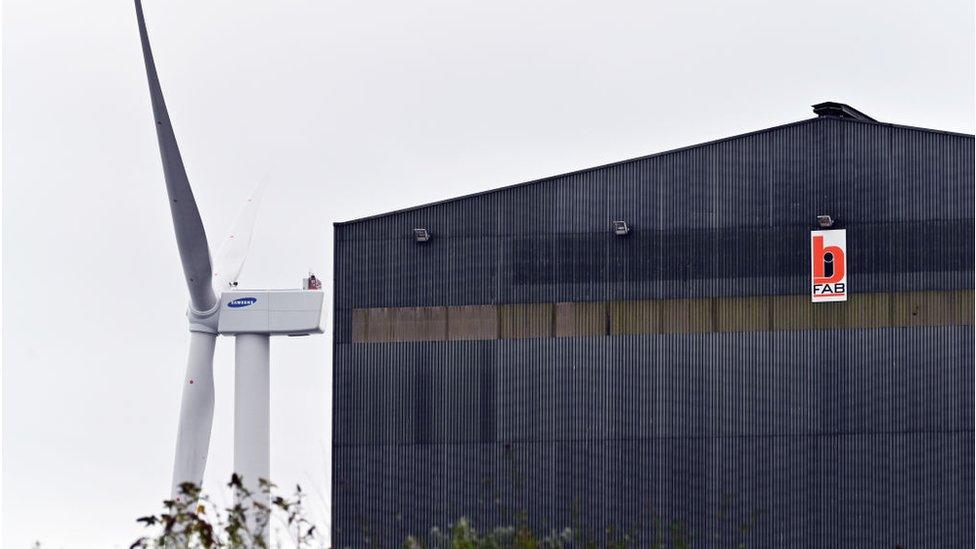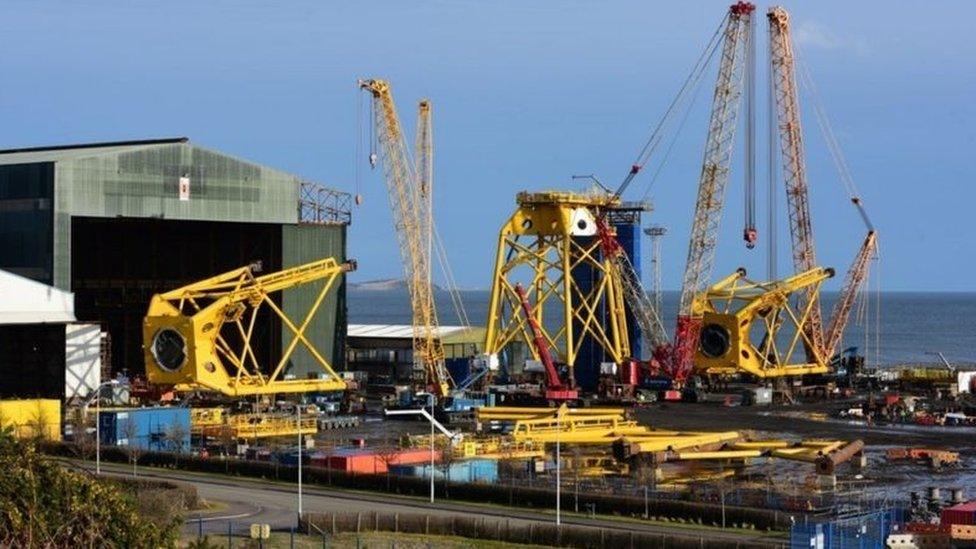What future for Scotland's heavy engineering yards?
- Published

BiFab's once bustling Burntisland heavy engineering yard stands empty on the day it was announced the company had been put into administration
The collapse of BiFab fabrication yards isn't complete yet, and former prime minister Gordon Brown has a plan - as well as fury at what has been allowed to happen.
The Scottish government has sunk £52m in the company, so how much might it recover as a creditor and shareholder?
What is the future for the Fife and Lewis yards, and for several others with potential in growing markets for new energy and breaking up of old ones?
Is BiFab's Christmas goose fully cooked? The steel fabrication company thinks so, and its majority shareholder in Canada. So does the Scottish government, the minority shareholder that paid £37m for its one third stake.
But perhaps it's not over yet, while intention to appoint administrators has yet to lead to the actual handover. And not according to the former Prime Minister, Gordon Brown.
As a former Labour MP for Fife constituencies including Burntisland, and no stranger to its fabrication yard, he is taking a close interest in the kingdom's economy and has trenchant views on the company's apparent demise.
He reckons there are about 10 days to turn this around. Other insiders on this deal suggest there are fewer. So what does he think can still happen?

Former prime minister Gordon Brown says the yard can be saved
The Scottish and UK governments could still combine to provide the £30m contract guarantee needed to secure a contract to build eight offshore turbine platforms, employing more than 400 people.
Mr Brown flatly rejects the legal argument deployed by Scottish economy secretary Fiona Hyslop.
She says European state aid rules preclude governments in either Holyrood or Westminster from providing finance that could and would not be provided by a commercial company.
Ms Hyslop adds that DF Barnes, the Canadian majority shareholder that was brought in by ministers to do the engineering, has not been providing any significant investment.
We haven't seen the legal advice, but Mr Brown joins opposition MSPs and trade unions in questioning why European rules will apply at the end of the month, after a full Brexit break from Brussels regulations.
I asked Fiona Hyslop about this. Her view is that ministers are bound to observe the law, and no-one can tell her what law will apply next year.

Scotland's economy minister Fiona Hyslop says European state aid rules preclude governments from providing finance that would not be provided by a commercial company
To a risk-taking minister, that might be the kind of challenge they like.
It's observed that Ms Hyslop was preceded in the economy role by Derek Mackay, whose risk-taking in his personal life brought him down last February.
But when applied to business, it may also have given the Renfrewshire MSP a bolder vision of what could be achieved.
That goes for BiFab, and also for Ferguson shipbuilder in Port Glasgow, taken into public ownership on his watch.
Gordon Brown told the BBC's Good Morning Scotland: "A new minister came in, I think there was new advice given by the civil service, but actually fundamentally the position of the company had not changed and the contract should have gone ahead.
"Why is it, when you win a contract, you can't discharge it? Because the Scottish government pulls the plug on it at the last minute.
"It's completely unacceptable and I believe that it's doing terrible damage to the Fife economy, because we want to win this work in the North Sea and we want to be part of this new renewables industry which is going to create a better environment as well as create jobs in the country."

Bifab withdrew from the bid process to secure work supplying metal "jackets" for a windfarm off the Fife coast
The former prime minister has been talking to Whitehall, to BiFab and to its Canadian majority owner.
He talks up the prospects for others saving the yards, and is calling for full inquiries at both Holyrood and Westminster into what went wrong with BiFab.
"I know for a fact that there's a Chinese company interested in looking at the yards," he says. "I know also that the workforce representatives are determined to find work for the area.
"So we're not going to give up. If, after 100 years of serving the community, we can't do better by BiFab, the Scottish Government have to think about the type of economic and industrial policy they're operating.
"I have not seen for a long time such scandalous behaviour that requires an investigation not just by the Scottish Parliament but the UK Parliament as well.
"We are supposed to be building a future in the North Sea in renewables, and we are throwing it away by decisions like this one by the Scottish government."
The Scottish government, obviously, disagrees, though it is not pretending this is a happy position to be in. Governments have to take risks, and this one didn't work out, according to Fiona Hyslop.
The best she can say of the £52m sunk in BiFab is that it helped the company complete an order for the Beatrice wind farm in the Moray Firth - now operational and a project, they imply, that might otherwise have foundered.
How much will be recovered once administrators get to work, gathering assets and selling them for the best price they can secure in creditors' interests?
As lead creditor, the Scottish government could hope to see much of its £15m returned. The assets don't include the yards, which are owned by Scottish Enterprise (Methil), Highlands and Islands Enterprise (Arnish in Stornoway) and privately-owned Forth Ports, which owns Burntisland.
There is some equipment on the sites. But the biggest asset may be an expected incoming payment of between £10m and £12m from a supplier of steel to the Lewis yard two years ago. It has been in dispute over the quality of product delivered, and it seems that BiFab won.
But as for the other £37m, it is equity, some of it converted from loans. In administrations, shareholder stakes are at the end of the employee, tax collector and creditor queue. Recovery of that looks very unlikely.
What about the yards' future?
Could there be a Chinese company coming in to make use of them, as Gordon Brown suggests?
It wouldn't be that surprising. The Fife yards are well-located quayside assets for firms supplying the North Sea, if only for laying down stock and supplies.
There are new technologies being developed for commercial roll-out, including tidal power, floating wind turbine bases which use similar designs to semi-submersible oil and gas production, with which Scottish yards have experience. There may, one day, be a return to wave power fabrication at scale.
Meantime, I hear that Arnish in Lewis is being considered for a different future as a base for decommissioning offshore oil and gas equipment.
That is a business opportunity worth tens of billions in coming decades. Teesside established a lead as the North Sea's breakers yard, but Lerwick is currently host to the former Ninian platform, and there is capacity in other yards.
Indeed, that is important to remember. The BiFab yards gained prominence because they were rescued, and the focus of so much Scottish government effort.
But there is Nigg in Easter Ross. Rosyth in Fife, with its own energy park, has space for further activity. There has been talk of re-opening the deep water facility at Loch Kishorn in Wester Ross. And Hunterston in North Ayrshire is looking to a new energy future beyond nuclear power.
Could they compete with the efficient production lines in China, Indonesia, the United Arab Emirates and Spain, where North Sea jackets are currently being built?
Possibly, they could, with both public and private investment, but they'll also require imagination, determination and consistency.
- Published3 December 2020

